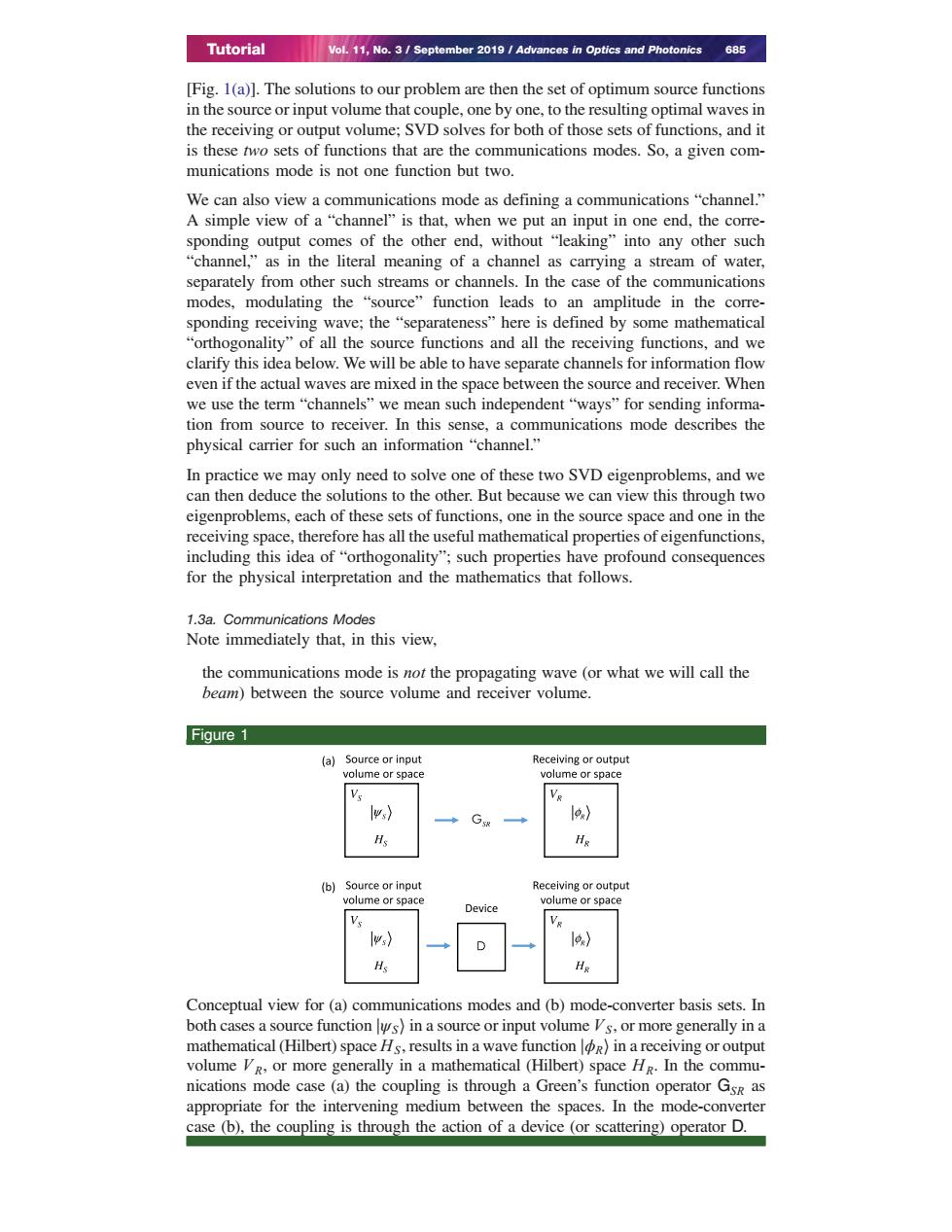正在加载图片...

Tutorial Vol.11,No.3/September 2019/Advances in Optics and Photonics 685 [Fig.1(a)].The solutions to our problem are then the set of optimum source functions in the source or input volume that couple,one by one,to the resulting optimal waves in the receiving or output volume;SVD solves for both of those sets of functions,and it is these two sets of functions that are the communications modes.So,a given com- munications mode is not one function but two. We can also view a communications mode as defining a communications "channel." A simple view of a "channel"is that,when we put an input in one end,the corre- sponding output comes of the other end,without "leaking"into any other such "channel,"as in the literal meaning of a channel as carrying a stream of water, separately from other such streams or channels.In the case of the communications modes,modulating the "source"function leads to an amplitude in the corre- sponding receiving wave;the "separateness"here is defined by some mathematical "orthogonality"of all the source functions and all the receiving functions,and we clarify this idea below.We will be able to have separate channels for information flow even if the actual waves are mixed in the space between the source and receiver.When we use the term "channels"we mean such independent "ways"for sending informa- tion from source to receiver.In this sense,a communications mode describes the physical carrier for such an information "channel." In practice we may only need to solve one of these two SVD eigenproblems,and we can then deduce the solutions to the other.But because we can view this through two eigenproblems,each of these sets of functions,one in the source space and one in the receiving space,therefore has all the useful mathematical properties of eigenfunctions, including this idea of"orthogonality";such properties have profound consequences for the physical interpretation and the mathematics that follows. 1.3a.Communications Modes Note immediately that,in this view, the communications mode is not the propagating wave (or what we will call the beam)between the source volume and receiver volume. Figure 1 (a)Source or input Receiving or output volume or space volume or space V g v) lx) Hs Hg (b)Source or input Receiving or output volume or space volume or space Device Vs 1)》 Hs Hg Conceptual view for (a)communications modes and (b)mode-converter basis sets.In both cases a source function lus)in a source or input volume Vs,or more generally in a mathematical (Hilbert)space Hs,results in a wave function )in a receiving or output volume VR,or more generally in a mathematical (Hilbert)space HR.In the commu- nications mode case(a)the coupling is through a Green's function operator Gsk as appropriate for the intervening medium between the spaces.In the mode-converter case (b),the coupling is through the action of a device (or scattering)operator D.[Fig. 1(a)]. The solutions to our problem are then the set of optimum source functions in the source or input volume that couple, one by one, to the resulting optimal waves in the receiving or output volume; SVD solves for both of those sets of functions, and it is these two sets of functions that are the communications modes. So, a given communications mode is not one function but two. We can also view a communications mode as defining a communications “channel.” A simple view of a “channel” is that, when we put an input in one end, the corresponding output comes of the other end, without “leaking” into any other such “channel,” as in the literal meaning of a channel as carrying a stream of water, separately from other such streams or channels. In the case of the communications modes, modulating the “source” function leads to an amplitude in the corresponding receiving wave; the “separateness” here is defined by some mathematical “orthogonality” of all the source functions and all the receiving functions, and we clarify this idea below. We will be able to have separate channels for information flow even if the actual waves are mixed in the space between the source and receiver. When we use the term “channels” we mean such independent “ways” for sending information from source to receiver. In this sense, a communications mode describes the physical carrier for such an information “channel.” In practice we may only need to solve one of these two SVD eigenproblems, and we can then deduce the solutions to the other. But because we can view this through two eigenproblems, each of these sets of functions, one in the source space and one in the receiving space, therefore has all the useful mathematical properties of eigenfunctions, including this idea of “orthogonality”; such properties have profound consequences for the physical interpretation and the mathematics that follows. 1.3a. Communications Modes Note immediately that, in this view, the communications mode is not the propagating wave (or what we will call the beam) between the source volume and receiver volume. Figure 1 Conceptual view for (a) communications modes and (b) mode-converter basis sets. In both cases a source function jψSi in a source or input volume VS, or more generally in a mathematical (Hilbert) space HS, results in a wave function jϕRi in a receiving or output volume VR, or more generally in a mathematical (Hilbert) space HR. In the communications mode case (a) the coupling is through a Green’s function operator GSR as appropriate for the intervening medium between the spaces. In the mode-converter case (b), the coupling is through the action of a device (or scattering) operator D. Tutorial Vol. 11, No. 3 / September 2019 / Advances in Optics and Photonics 685